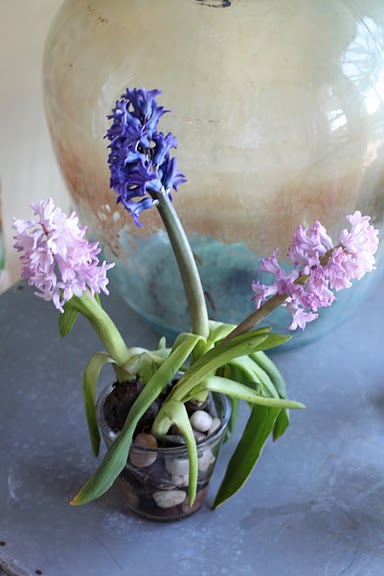And in thy store there be but left,
Two loaves, sell, and with the dole,
Buy Hyacinths to feed the soul.
-Muslih-uddin Sadi
If that poem doesn’t speak to your spirit, then I don’t know what will! A poet after my own heart…feeding their soul with flowers! Once you have grown, seen and smelled hyacinths, you too will know the power of their intoxicating fragrance, the paradoxical complement of earthy bulb and delicate bloom, and the sheer delight such a little dose of this spring time flower can bring.

Hyacinthus orientalis or the common Dutch Hyacinth is the prototypical image our minds conjure up when thinking about hyacinths. Though there are many different species to admire and grow, including the Grape Hyacinths (Muscari spp.)
From the grocery store to the garden center, hyacinth bulbs and flowers have become easily obtainable to our market. If all you do is smell them, you too will become intrigued and bemused by their jaunty, spring floral bouquet that is the perfect perfume for the vernal equinox.

With colors that range from soft, buttery yellows to jewel tones of deep amethyst and aubergine, to the purest of white, I’m sure there is a hyacinth for your home and garden. The color blue, pure blue, can be a rarity in the plant kingdom, and hyacinths boast a gorgeous palette of blues, from lapis to indigo to sky.
And what better of a story can a flower have than its own place in mythology! The mythological story of hyacinths is a classic Greek tragedy, full of love, blood, dueling gods. Commonly associated with rebirth, we often see hyacinths used appropriately enough at their bloom time in early spring.

In Victorian times, the language of flowers became a dialogue of its own, with the hyacinth representing fun sport. Not so odd when you realize that the name came from the ancient game of throwing a Zephyr and Apollo throwing a discus to young Hyakinthos. Well, maybe still odd. Anyways, the blue hyacinths represent sincerity, which is a fantastic and lovely for one of the sincerest of all blue flowers.
So, now with sincerity of my own, plant, arrange, force, and smell hyacinths in your home and garden. I’m quite sure after offering their first fragrance and beautiful blooms, you too will have fed your soul.

A few fun ideas and tips for hyacinth employment and enjoyment…
· Force the bulbs in water and rocks in a sunny spot and watch the miracle or horticultural life spring up out of a papery skinned bulb…simply amazing process.

· When forcing hyacinths, use a clear, thick glass container so you can gage the water content…keep the bottom of the bulbs touching the water…don’t drown them. You can use pretty rocks and shells as anchors for the bulbs too.
· Buy hyacinths in tight buds from the florist and make a simple arrangement of them for a week or more of enjoyment inside. They make super cut flowers, elegant nosegays, and will perfume the whole house.
· Plant a composition of hyacinths, daffodils, and tulips for a springtime celebration in your own garden. Since they bloom within close proximity, you can have a great period of delight from these fantastic combos of bulbs and flowers.
· Plant spring blooming hyacinths in the fall (October- November in the Deep South) in good garden soil with plenty of organic material. Once the flowers have bloomed, don’t cut back the leaves – that’s the food for next year’s flower. The adage is true for daffodils.
· Plant summer blooming hyacinths in the spring…these fun little plants are nice surprise come summertime!
· Check out different color varieties, such as ‘Gypsy Queen,’ one of this Farmer’s favorite colors and flowers. It is a soft apricot and deliciously fragrant!
· Though non-native but becoming invasive, the Water Hyacinth is an aquatic plant seen in many ponds and swamps. Native to South America, this plant has pretty hyacinth-ish flowers and color but is actually considered a plant pest.


No comments:
Post a Comment